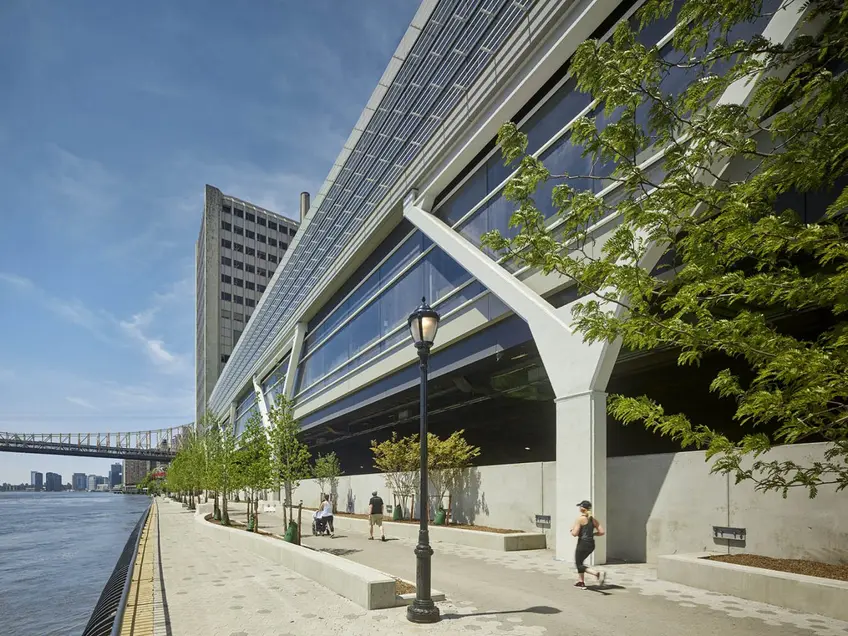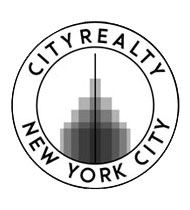 River walk adjacent to Stavros Niarchos Foundation-David Rockefeller River Campus via Rafael Vinoly Architects
River walk adjacent to Stavros Niarchos Foundation-David Rockefeller River Campus via Rafael Vinoly Architects
In the dead of the night, like a perfectly timed heist, a barge transported portions of Rockefeller University’s Campus Extension across the East River. Each piece, two stories high, weighs between 700 and 1,000 tons. "There was only one crane that could do it," explains George Candler, Rockefeller’s Associate VP of Planning and Construction. It was complicated to say the least. “The crane itself doesn't move on the barge. Instead, the entire barge swings around. So when it swings perpendicular to the shore, it's sticking about a third of the way into the East River. The only time we could do that was when the tide changed.”
The construction team for the project only has a couple hours of calm water a night, but those hours of calm didn't always occur during the times that the Department of Transportation could shut down FDR Drive, which straddles the eastern edge of the renowned university. A tide chart was consulted, and the right nights were picked so that, between the hours of 1 and 5 AM, the campus extension could be assembled. But that’s only part of the story.
“Rockefeller University was founded in 1901,” says Jay Bargmann, Vice President of Rafael Viñoly Architects, the firm that was commissioned to plan the campus extension. “Its buildings sit on a cliff that run along the edge of the East River. That cliff, however, is itself a building that all the other buildings sit on top of. And the buildings themselves are also connected from north to south, so that you can walk from one building to another without ever leaving the building, which enhances the sense of community.”
That sense of community was preserved, says Bargmann. “All of the circulation is very integrated, so every researcher should come into contact with every other researcher throughout the course of the day.” But because that sense of community, and the university itself, rests on a cliff, it further complicates the construction project.
“The building curves over this three-and-a-half-block area,” explains Candler, “So it’s not a square building. All the frames are not rectangular and square, so they all had to be leveled. And then some of them had to slot between existing buildings. So, they had spotters with lasers up there saying, you know, ‘An inch over here, an inch up an inch down,’ because you can imagine the damage you could do if you swung something and hit a building with it.”
Thankfully, nothing of the sort happened, and the extension is well on its way to being complete.
Outdated research areas are being transformed into office space, and new laboratories have been added that can be upgraded as demanded by advances in science. Additionally, the garden designed by the renowned landscape architect Dan Kiley has been beautified, the seawall has been restored, and the esplanade was rebuilt with the same Vermont granite that made up the original river walk. The open spaces, which are open to the general public, will be preserved in perpetuity with a million-dollar fund.
Then there’s a view unlike any other in the city. "When you're inside the building, the east wall of the building is floor-to-ceiling glass," says Bargmann. “You get a spectacular view of the East River, which is quite spectacular. You just feel like you're almost on top of the water, looking down on it.” Add it all together, and it’s no surprise why Bargmann believes that Rockefeller University is “a jewel in Manhattan that very few people know about.”
Enjoyed this Article? Like CityRealty on Facebook and follow @CityRealty on Instagram. You can also tweet us at @CityRealtyNY.

Contributing Writer
Ben Kharakh
Ben Kharakh is a writer and comedian living in the New York City metropolitan area. His work has appeared in Vice, Fortune, and The Best of McSweeneys: Humor Edition by Vintage Press.

 6sqft delivers the latest on real estate, architecture, and design, straight from New York City.
6sqft delivers the latest on real estate, architecture, and design, straight from New York City.
